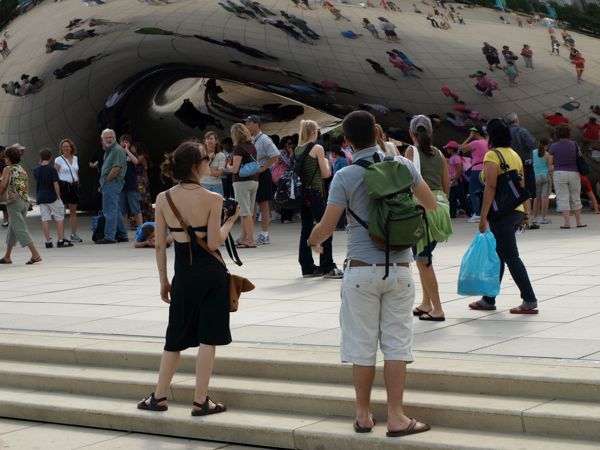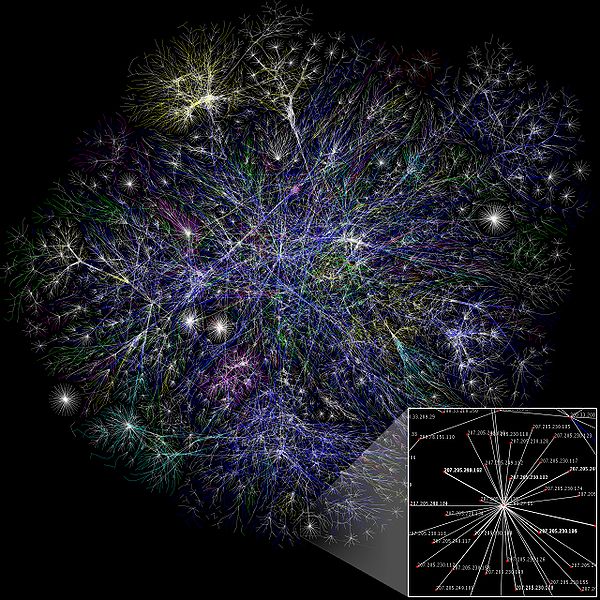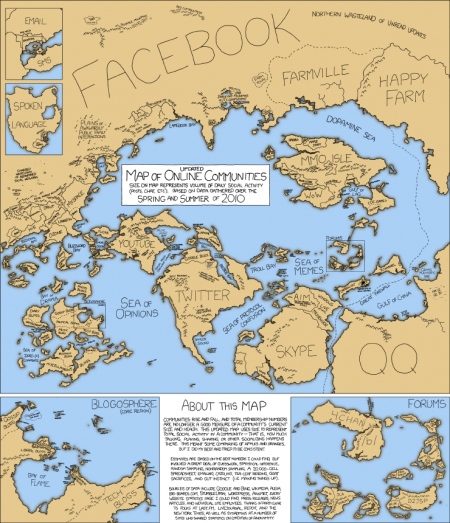Serendip is an independent site partnering with faculty at multiple colleges and universities around the world. Happy exploring!
Interacting/Intervening/Innovating
To: The Shuttleworth Foundation
From: Anne Dalke
Re: The world as it is, what change I want to make, what I want to explore, and what I am going to do to get there
See also the accompanying video
 From Charles and Ray Eames, Powers of Ten |
“Life multiplies when two systems interact” (A sign at The Wild Center, a nature museum in the Adirondacks, New York State, USA). “This is a quantum universe, neither random nor determined. It is potential at every second. All you can do is intervene” (Jeanette Winterson, The Stone Gods, 2008). The famous Eames video, Powers of Ten, is the best representation I know of the world as it is: the film showcases the largest and smallest dimensions of the context in which I work, and to which I attend. I like watching it with the sound (and the voice of the explicator!) turned off, the better to see for myself the magnitude of the universe extending beyond, and the infinitude of the microscopic world within us all. Yet note the gutters that separate each of images to the left. What is missing from this expression of the scope of the world is any sense of interaction among the various levels represented. For the past thirty years, I have located myself in those gaps, at that pivot point at the center of the video where the camera, zooming from the galactic to the quantum scale, passes through the level of the human body. I position myself, in particular, in those places where human brains can interact, intervening to make those interactions more collaborative and open-ended. |
|
In search of ever-more inclusive sites for such interactions, I have gone exploring in multiple directions, in the company of students and of colleagues whose training differs from my own, with an evolving awareness that we can all learn from one another, that “truth can come from any source.” We have joined together in classrooms, on the campus of a woman's college where I teach, and in larger social networks to create communities that center on the edge of established disciplinary frames: places where we include ourselves among the objects we study, learn reciprocally from one another, and create and examine new territory together. Our search has an insistent social justice dimension: we understand that education operates as a form of negotiation, and seek to make room for individuals in the construction of social meaning. We are particularly interested in various forms of representation as means of seeking—and speaking with—authority, in the democratic possibilities of images and various other web-based forms of exchange and communication. |
 From An Evolving Occasion of Indeterminate Duration |
 Partial map of the Internet based on the January 15, 2005 data found on opte.org. Each line is drawn between two nodes, representing two IP addresses. |
Our work is insistent about the evolutionary—that is, only partially directed and therefore somewhat unpredictable—outcomes of educational interactions. Each of our projects acknowledges multiple ways of making sense of any given set of observations, no matter how extensive; an awareness that the products of study can never be fully objective, but will always reflect particular perspectives; and a consciousness that inquiry is fueled by a strong social dynamic. Our collaborative works are both expressions and extensions of co-teaching, testaments to an evolving pedagogy in co-constructing knowledge, and in which the wealth of that construction is fed by multiplying the interactions among us. We have a particular interest in the ways in which new technologies have changed both the methods and materials of our thinking; we have responded enthusiastically to the democratization of educational institutions and social spaces opened up by such innovations.
For the past ten years, almost all of our work has been enacted and archived on the site where I am now submitting this application: a digital ecosystem fueled by serendipity. This studio-lab called Serendip is a deliberate experiment in knowledge construction, conducted on an open platform with open-ended aims. It is a gathering place for people who suspect that life's instructions are always ambiguous and incomplete: both an expanding forum and a continually developing set of resources for exploring and supporting intellectual and social change in education, in social organization--and in how one makes sense of life. |
| Serendip is a powerful vector for uniting ideas and stories with all sorts of minds. Its most salient features are its unique, over-time character; its sheer power as an archive, not only of finished text, but of conversation and emergent inquiries; and its values, both articulated and enacted, of self- and community-directed learning: pursuing questions, re-thinking authority, and, most important, experimenting and innovating. This coming fall, for instance, one of my classes will meet in the woods, and another with incarcerated women inside a correctional facility. Both these courses--one going “outside” and the other “inside"--will also be hosted virtually, on Serendip, where students will be in conversation with others engaged in similar forms of inquiry, as they learn to represent the natural world in digital form, and to talk across difference with women whose lives have taken very different directions than their own. Such classes, offered on Serendip, never mark their own horizons. The radical open-endedness of this network differs profoundly from all the course management sites I know, as well as from internet businesses such as Google, whose ends are not so open. I see the woman’s college where I teach as a crucial site for such an open space, because historically women have been denied the possibilities of living in this way: a globalized Bryn Mawr is increasingly attempting to intervene in a world history of the silencing of women. Even more importantly, I see Serendip's playing a crucial role as a digital location where people living anywhere and everywhere might speak with one another about their visions for social change, and so begin to bring them to reality. |
 From Bryn Mawr's visit to Parkway West High School |
 Updated Version of On-Line Communities |
Serendip already has five million unique visitors a year. We also experiment with community partnerships; recently, these have included a high school in a nearby city, a university in a city further off, and the Titagya program building preschools and kindergartens in Northern Ghana. Where else might we go in search of inclusive conversation? What might Serendip evolve into that it has not yet been? What I want to explore during the upcoming year is the range of such possibilities, with others who prize interactions among people beyond a single college campus. I want to expand the organic intellectual site we have created into one that is even more collaborative and attentive to the ways in which the web offers enlarged senses of both time and space. I want to find out how cascade-able, and how sustainable, the vision is that has fed Serendip for all these years. I want to learn what institutional openings exist, or might be created, for bringing people around the world into the conversations and actions hosted on this emerging site. To answer these questions, I want to spend the upcoming year planning with others working in the emergent technologies of education, both inside and outside educational institutions, which are open to all comers and discourses. With a changing community of practitioners, I want to create a range of new conversational sites, as a contribution towards more lively, open-ended dialogue, on campus and beyond. As Karen Barad makes clear, in her compelling articulation of the relationship between the entanglements of quantum physics and that of social justice work, there is one world, of which we are all a part, in which we are all agents, which we are shaping as we go. I seek that emerging shape here. |
| Attachment | Size |
|---|---|
| DalkeAbbreviatedC.V3-2-12.docx | 153.77 KB |



Comments
Post new comment